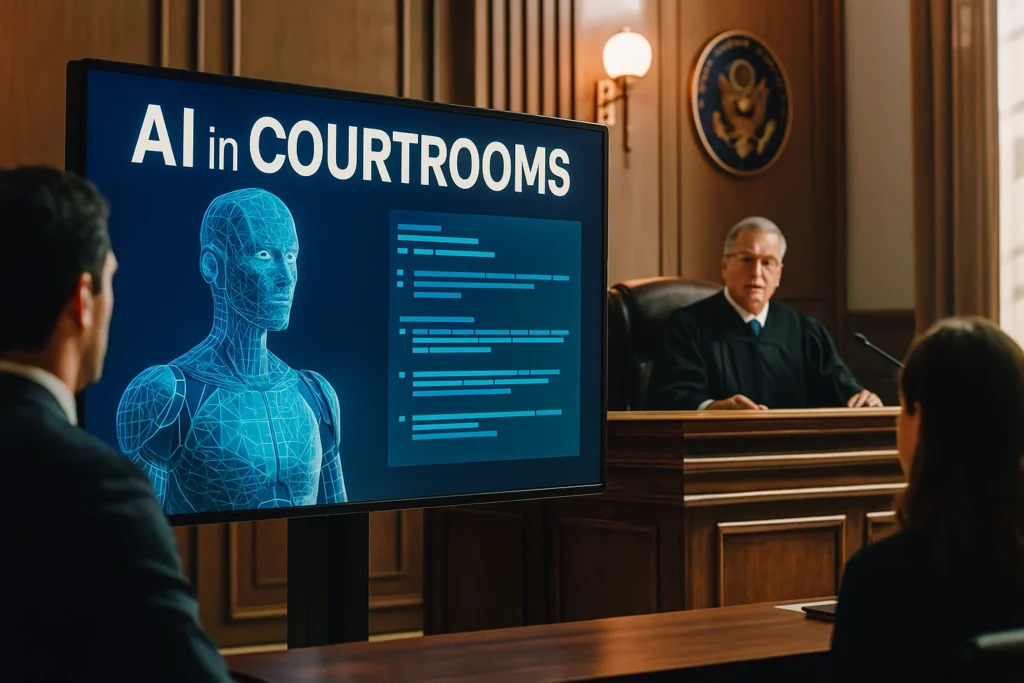Introduction: Justice in the Digital Age
Imagine a courtroom where dusty legal tomes are replaced by glowing screens, and complex decisions are helped along by powerful algorithms. This isn’t just a scene from a futuristic movie anymore. In 2025, Artificial Intelligence (AI) is starting to play a major role in judicial systems around the world, from predicting case outcomes to assisting lawyers and even hinting at how sentences might be decided.1
This technological revolution promises a faster, more efficient path to justice, potentially clearing the massive backlogs that plague courts globally. But like any powerful tool, AI in the courtroom comes with urgent questions: How can we ensure fairness if the data it learns from is flawed? What happens to the human touch of empathy when machines are involved? And who is truly accountable when an AI influences a life-altering decision? This article will explore the fascinating and often challenging ways AI is reshaping legal systems, raising vital discussions about justice, transparency, and the irreplaceable role of human oversight.
Global Experiments: Nations Embracing AI in Justice
Across the globe, various countries are boldly experimenting with AI-powered tools, eager to harness the technology’s potential to modernize their legal systems. Each nation approaches this frontier with its unique needs and existing legal structures.
Pioneers of Digital Justice
- Estonia: The Digital Frontrunner: Known for its highly digitized public services, Estonia has been at the forefront of exploring AI in its legal system.2 While not fully replacing judges, Estonia has looked into using AI for small claims court cases.3 Imagine minor disputes, like simple contract disagreements over a few thousand euros, where an AI could act as a “smart assistant” for judges, helping to process information and even suggest rulings, all subject to human review. This aims to streamline mundane tasks and free up human judges for more complex matters.
- China: Efficiency at Scale: China is arguably the most ambitious in applying AI to its vast judicial system. Their “smart courts” leverage AI for a wide range of tasks: managing huge volumes of cases, reviewing evidence, conducting extensive legal research, and even providing sentencing tools that recommend punishments based on similar past cases. The goal is to dramatically increase efficiency, standardize judgments across the country, and reduce the burden on human judges.
- United Kingdom: Focus on Administration and Prediction: The UK is also deeply invested in legal AI, though often with a focus on supporting roles rather than direct decision-making. AI is extensively used for advanced legal research, e-discovery (sifting through massive amounts of digital evidence in large cases), and predicting case outcomes to inform legal strategy.4 This helps lawyers advise clients more effectively and allows courts to manage administrative tasks more efficiently.5
Beyond these examples, countries like the United States, Canada, and various European Union nations are exploring different levels of AI integration, from AI-powered chatbots offering basic legal information to sophisticated tools aiding in complex litigation.6
The Double-Edged Sword: Efficiency vs. Bias
The promise of AI in courtrooms is clear: to clear overwhelming case backlogs and bring faster justice. AI can process information at speeds no human can match.7 However, this efficiency comes with a significant risk: the potential for bias if the data it learns from is flawed.
Speed and Its Perils
- Boosting Efficiency: AI excels at tasks that involve pattern recognition and data analysis.8 In a legal context, this means it can:
- Review Documents Rapidly: Analyze thousands of pages of contracts or discovery documents in minutes, flagging key clauses or relevant information.9
- Predict Outcomes: By analyzing past judgments and case details, AI can predict the likely outcome of a case, helping lawyers and parties decide whether to settle or proceed to trial.10
- Automate Administrative Tasks: Handle scheduling, generate routine legal documents, and manage court dockets, freeing up valuable human time.11 These capabilities directly help reduce case backlog, making legal processes quicker and potentially more accessible.12
- The Problem of Bias: The core danger lies in the data. AI learns from historical information, and if that information reflects existing societal biases, the AI will internalize and perpetuate them.13 For instance, if past sentencing data shows disproportionate outcomes for certain demographic groups, an AI trained on that data might unknowingly recommend harsher sentences for individuals from those groups. This risk of bias if data is flawed is not a bug; it’s a fundamental feature of how AI learns, and it raises profound questions about fairness and transparency in justice. An AI’s “decision” might simply be a reflection of historical injustice, cloaked in the guise of objective technology.
Ensuring unbiased data and constantly auditing AI systems are critical challenges that judicial systems must address to prevent AI from inadvertently magnifying existing inequalities.14
The Legal Tech Revolution: AI as a Lawyer’s Assistant
Beyond the courtroom itself, AI is rapidly transforming the practice of law, giving rise to a booming industry of legal tech startups.15 These companies are developing powerful AI-based tools that act as sophisticated assistants for lawyers, changing everything from how contracts are drafted to how cases are strategized.16
From Drudgery to Data-Driven Decisions
- AI-Based Contract Review: One of the most common applications is in contract review. Instead of lawyers spending hours meticulously reading through lengthy legal documents, AI can now analyze contracts in seconds, identify specific clauses, flag potential risks, ensure compliance with regulations, and even compare them against industry standards.17 This saves immense time and reduces human error.
- Litigation Strategy: AI tools can also aid in litigation strategy.18 By analyzing vast databases of past cases, judge rulings, and jury outcomes, AI can help lawyers predict the likelihood of success for different legal arguments.19 This provides data-driven insights that can inform decisions on whether to settle, which arguments to emphasize, or even how to select a jury.20
- Defense Assistance: For defense attorneys, AI can be invaluable in defense assistance.21 It can quickly sift through discovery documents to find crucial evidence, identify patterns in prosecutor behavior, or locate precedents that support a particular defense strategy.22
- Legal Research on Steroids: AI-powered legal research platforms have revolutionized how lawyers find information.23 Instead of keyword searches, AI can understand complex legal questions and pull up relevant statutes, case law, and scholarly articles much faster and more comprehensively than traditional methods.
These AI tools aren’t replacing lawyers, but they are dramatically changing the legal profession, allowing legal professionals to focus on high-level strategic thinking, client relations, and the nuanced arguments that still require human judgment.24
Public Apprehension: “Robo-Judges” and the Question of Empathy
While AI offers promises of efficiency, the public response to its deeper integration into justice systems is often one of caution, and sometimes outright fear.25 The very idea of “robo-judges” making decisions that impact human lives raises profound questions about the nature of justice and the irreplaceable role of empathy.26
The Human Element
- Fear of Depersonalization: For many, the concept of a “robo-judge” conjures images of cold, unfeeling machines. Justice is deeply personal. It involves listening to testimonies, understanding individual circumstances, and assessing remorse. The public worries that AI, however smart, cannot replicate this human element, leading to a depersonalized and unfeeling justice system.
- Lack of Empathy: A central concern is the question of empathy in justice. AI operates on algorithms and data, not emotion. It cannot feel the weight of a victim’s suffering, understand the nuances of a difficult upbringing, or discern genuine remorse. These are qualitative factors that human judges, juries, and lawyers consider, and they are vital for a justice system that is perceived as fair and humane.
- Privacy Concerns: The development and deployment of AI in courtrooms often require access to vast amounts of sensitive personal data.27 This raises significant privacy concerns among the public about how their information is collected, stored, and used by these systems, particularly in cases involving criminal justice.28
- Right to Human Review: There’s a strong public sentiment that any decision influenced by AI, especially in criminal cases, must ultimately be reviewed and ratified by a human. The idea of an appeal to a machine, or being judged by an unfeeling algorithm, is deeply unsettling.
These public sentiments underscore a fundamental tension: the desire for efficiency must be balanced with the need for a justice system that is perceived as fair, humane, and rooted in human values.
Global Safeguards: Legal Reforms and Regulatory Guardrails
Recognizing both the immense potential and the inherent risks of AI in justice, there is a strong global movement towards establishing legal reforms and calls for regulatory guardrails to ensure that human accountability remains central.
Building Ethical Boundaries
- Council of Europe Guidelines: Organizations like the Council of Europe have taken a proactive stance.29 Their European Ethical Charter on the Use of Artificial Intelligence in Judicial Systems (CEPEJ) provides a framework of principles.30 These principles emphasize that AI tools must be developed and used with respect for fundamental rights, ensuring:
- Respect for Fundamental Rights: AI systems must not discriminate or violate human rights.
- Transparency: The algorithms and data used by AI should be understandable and auditable (explainable AI).
- Neutrality: AI must be impartial and free from bias.
- Security and Data Protection: Robust measures must be in place to protect sensitive legal data.31
- Human Oversight: Crucially, AI should always remain under meaningful human control, with human accountability for final decisions.32
- UN Initiatives: The United Nations and its various bodies are also engaging in discussions around AI and human rights, including its application in legal systems.33 They advocate for international cooperation to develop ethical guidelines and ensure that AI technology serves justice rather than undermining it.
- National Legislations: Countries are beginning to grapple with this at a national level. Some are focusing on mandatory human review for any AI-generated recommendations, while others are exploring certification processes for AI tools used in legal settings. The goal is to ensure that ultimate responsibility for decisions remains with a qualified human judge or legal professional.
- Explainable AI (XAI): A key demand from legal and ethical experts is the development of Explainable AI (XAI).34 This means AI systems should not operate as “black boxes,” but rather be able to clearly explain how they arrived at a particular recommendation or outcome, making them auditable and allowing for challenges if biases are detected.35
These global efforts aim to prevent a future where justice is outsourced to unthinking machines, ensuring that AI remains a tool to assist, not replace, the fundamental human values at the heart of legal systems.
Conclusion: The Future of Fairness in a Connected Courtroom
In 2025, artificial intelligence is no longer a distant concept but a tangible presence within courtrooms and legal offices worldwide. Countries like Estonia, China, and the UK are leading the charge, experimenting with AI-powered tools that promise to reduce case backlog and enhance efficiency. The rapid growth of legal tech startups offering AI-based contract review, litigation strategy, and defense assistance is transforming the practice of law, making legal processes faster and more data-driven.36
However, this technological leap comes with inherent risks. The potential for bias if data is flawed raises urgent questions about fairness and transparency, while the concept of “robo-judges” stirs deep public apprehension regarding the absence of empathy and human nuance in justice.37 These concerns are driving global legal reforms and fervent calls for regulatory guardrails, emphasizing the critical need for human accountability and oversight.
Ultimately, the integration of AI in courtrooms is a double-edged sword. It offers unprecedented opportunities to streamline justice and make legal services more accessible.38 But it also demands a constant vigilance to ensure that technological advancement never compromises the fundamental principles of fairness, human dignity, and ethical responsibility. As we move forward, the challenge for legal systems around the world will be to harness AI’s power wisely, ensuring that the pursuit of efficiency always serves the higher ideal of true, human-centered justice.



